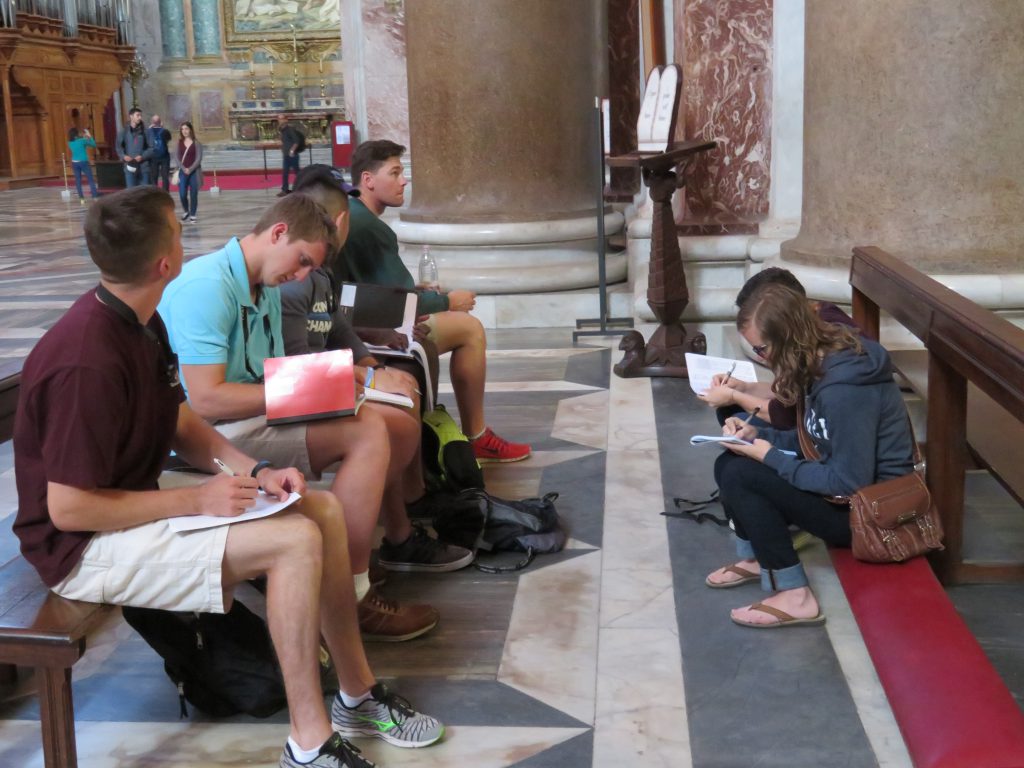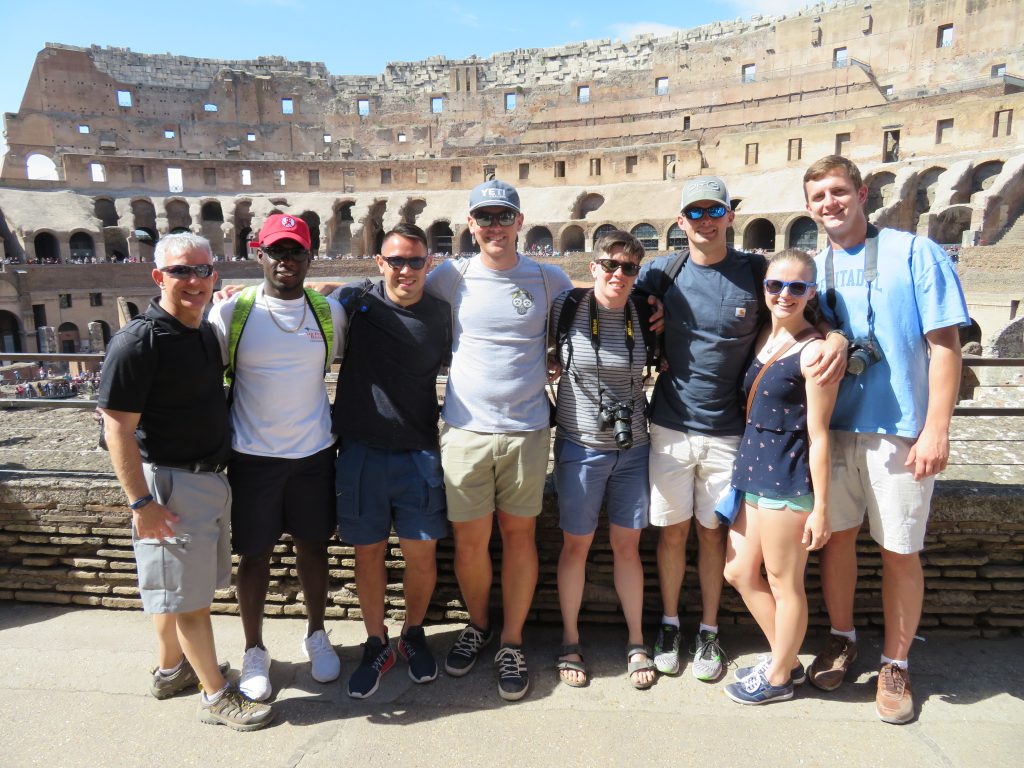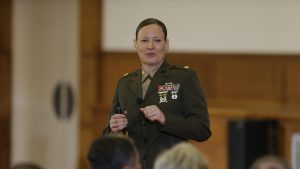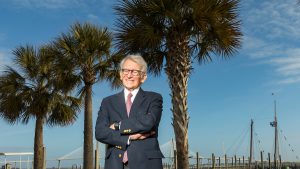Studying the Great Architectural Structures in Italy with a Critical Engineering Eye
With The Citadel’s growing focus on global learning, study abroad programs are more diverse and wide-ranging than ever. This summer, Ron Welch, dean of the School of Engineering, led students on a once-in-a-lifetime adventure. His mission? Introduce future engineers to the lessons of the past with a ticket to Italy’s most renowned architectural sites.
Mapping the Way
Why would a faculty member, let alone the dean of the School of Engineering, be a leader of a study abroad experience? This is a question that centers on the role of a teacher, whose job is to educate students about certain subjects. No matter how far I move up the administrative chain, one of my first loves has always been working with students to learn new engineering concepts. Sometimes doing so requires taking them out of the classroom and into the world, including visiting other countries to view the locale from a unique engineering perspective.

The current engineering study abroad experience is a three-week, multi-city trek across Italy to explore the historical and cultural implications of engineering and to immerse students in the study of ancient European and medieval engineering works of significance. Modes of study include sketching, load and stress computations, and construction means and methods. Students explore in detail the growth of civilizations as expressed in their monuments, infrastructure and great engineering works. Sites include fortifications, cathedrals, water works and roads.
Upon return, students deliver a presentation about their experience and what they learned to classmates and faculty as part of student chapter meetings. The condensed study abroad experience provides immersion learning for students who might not otherwise get the opportunity to study abroad because of the constraints of completing an engineering bachelor’s degree in four years and fulfilling summer activities required of fall athletes or cadets with military commitments.
Making Preparations
To prepare for the trip, each student is assigned a different location in Italy where he or she must determine key engineering or cultural sites the team should experience. Students also recommend the actual engineering analysis or design problem for each day in their assigned location. Of course, the professor has the final say on both where and what we study, but the opportunity for students to immerse themselves in one location deepens their experience and provides ownership of the learning process for the three-week period. Prior to departure, I meet with each student to further refine suggestions for locations. As part of the preparation for the trip, the students are required to purchase a journal (ideally one with engineering paper). All that is initially stated about the journal is that they will be required to complete a daily journal entry and analysis/ design problem each day.
The Journey Begins
After students check in at the Charleston airport, the real work begins when they are informed of the focal points for daily journaling. Military engineers have developed a process of assessing a location in the world to determine the best way to inform commanders how to make use of resources to improve the infrastructure. The acronym, initially named SWEAT, was later renamed SWEAT Plus. I use a variation of this as a way to focus on the key elements of a functioning society. The acronym stands for sewage, water, energy, academics and trash. Without the processing of sewage and trash and the availability of clean water in a systematic way, disease will flourish. Energy is necessary to keep perishables cold and provide heating and cooling to enhance quality of life. Local students should be in school preparing for the future of the region and not left to mischief.
I also include transportation, architecture, culture, infrastructure (overall), situational awareness (security), and personal feeling about the day. The goal is to improve their attention to detail as we move through the day and capture unique thoughts and impressions as they occur. This type of process also heightens their awareness of the major differences in each focus area. While in New York waiting for the flight to Rome, students begin defining what each item means to them to allow a deeper discussion of our focus for each day.
Itinerary
For our summer 2017 trip, we visited Rome, Venice, Turin, Florence, Pisa, Naples and Pompeii. Many of the students were surprised about how different each area of Italy was when they considered the focus areas. They were intrigued by German architecture and the modern feel of Turin, which is on the edge of the Alps in Italy. Upon further investigation, they discovered that Turin was almost totally destroyed during World War II and has always had a blend of Italian, German and Swiss residents before and after the war. When rebuilding, the residents were not trying to repurpose existing buildings, as seen throughout Italy, but Turin could use more modern construction methods and a layout of the city with full-size sidewalks (versus Florence), wider streets and pedestrian-only areas.
One of the consistent observations was the placement of schools off the traveled path and the use of few markings to denote a school area as compared to the United States. In Venice, one school was in two buildings separated by a canal, but we would not have known it was a school had its students not been having lunch. Citadel students marveled at the Italian students hanging out on the canal wall at lunch and going to the same food vendors that the tourists were visiting.
The biggest surprise was the availability of clean running (actually constantly running) water in almost every piazza. We filled up our water bottles at each piazza as we traveled. Even the small town in the Florence countryside where we visited a winery had the same ability to run water continuously, but instead installed an on-off valve. At one time the United States had water fountains in each park, but never have we provided clean, running water in each park, nor free water in each threeto-four block area as they do in Italy.
Rome
The other activity that students worked on each day was a design or analysis problem. The primary goal was to apply basic statics and strengths of materials concepts to consider how the great engineering marvels run or were constructed without modern tools. The first design mission occurred in Rome: How would you convert the Forum and the Colosseum to usable space while continuing to highlight the rich history on display?

This question was beyond anything students had done at this point in the curriculum and set the stage for the out-of-the-box thinking required throughout the trip. The second mission was at Santa Maria Church, where the inside was majestic compared to the rather dull outside that showed signs of centuries of deterioration: How did they set the large columns in the church? The columns of granite are close to 40 tons each, so how were they transported and lifted into place? Next was the Pantheon mission: How did they build the dome out of concrete without modern-day cranes? What supports were needed? If formwork was required, what was the order of work placement?
Throughout the trip there were impromptu lessons that did not result in a formal design/analysis solution. An example occurred when we crossed the Tevere River. The river was extremely green, which led to a discussion as to why it was so green (e.g., algae bloom or fertilizer). Students questioned how this occurred in a river when the phenomenon normally is found in ponds and asked if the water was drinkable. The answer is that weirs are used to maintain water height for boats along the river in the drier season, resulting in near stagnant water.
Venice
In Venice, the first mission was in the San Marcos Piazza where we traveled up the tower. The mission: What is the weight of the tower on the lower bricks in pounds per square inch? What was the process used to build the tower? What is the effect of a 0.5 and 1 percent lean in the tower? How does the stress change?
The Basilica de San Marcos was our next stop. Unfortunately, the basilica has experienced excessive settlement—heavy weight in certain sections and varying soil conditions led to uneven settlement—which has caused tremendous distress on the structure. The Italians have reinforced the structure and have done much work to slow the settlement, but many areas were off limits. The mission: Locate five areas of distress and discuss why they are occurring. How can they be corrected? Can this portion of the structure be stabilized?
A key structure for engineers to consider in Venice is the opera house La Fenice (the phoenix). After burning down three times—the most recent in 1996—it is the perfect location to study engineered fire protection. The mission: Study fire hazards, locate and determine acceptability of firefighting equipment, and determine proper egress for every area of the building.
Turin
The first mission in Turin: Compare and contrast water consumption in the United States with Italy. What are the primary differences? Why? Is tap water safe in Italy? Estimate how many plastic bottles are discarded each day. What is the environmental impact of discarded water bottles? What is the amount of energy required to produce plastic bottles? How many homes per year could you power with this energy? What are the carbon dioxide emission levels to produce this number of water bottles?
This mission and the next covered our time in Turin and the trip to Florence and were the result of observations made by the students as we traveled. The next mission posed this question: What are the public transportation modes in Italy (heavy rail, light rail, highway, subway, bus, bike, auto, motorbike and foot)? What are the advantages/disadvantages of each, especially considering economic, social, political and environmental conditions? What is the amount of energy to power the trains in Italy? How does that compare to the energy to produce water bottles?
Florence
In Florence, we traveled to see the leaning tower of Pisa. The mission: Study the famous failure and determine the factors contributing to its tilt. How has it been stabilized? How much more slant can it sustain before it fails? How much compression stress can the stone withstand before it crushes? What types of distress are seen in the tower as you climb the stairs? Could the structure be righted at this time? Why or why not?
The team then visited Ponte Vecchio, which is a major bridge congested with foot traffic visiting the gold and silver shops that replaced the original butcher shops. The mission: Determine whether the bridge was designed for current large pedestrian loads. Why or why not? How are building loads, especially those hanging off the side of the bridge, supported and attached to the bridge? What is the size of the load that is hanging off the sides of the bridge?
After visiting vineyards using organic farming, students were assigned the mission: What are the advantages and disadvantages to organic farming? How much water is required to cultivate 50 acres of Sangiovese grapes? Do the growers use the advantage of the terrain to determine where to construct their vineyards?
Last Days
On the trip back to Rome, where we continued excursions and visited Naples, the mission on the train: Compare and contrast Rome, Venice, Turin and Florence using our focus for daily journals (SWEAT-T, culture, infrastructure, architecture, air and water quality, and feelings each day).
In Pompeii, students were asked to solve this mission: How could you protect the village from lava, ash, earthquake and blast? Each student struggled with some part of these assignments, but eventually through active group discussions, calculations, drawings, web searches, and time spent pondering each mission over a number of days, they were able to develop a solution. This process allowed them to have a better understanding of how medieval structures were constructed and how to prepare a broader scope and think outside of the box during solution development.
Reflections Upon Returning
The three-week trek allowed the students to eat, breathe and live the culture of Italy through a focus on the history (design and analysis) of Roman and medieval engineering and society. By the end of the trip, students felt comfortable communicating and functioning in a foreign setting and gained an appreciation for the important perspectives and achievements of other peoples and cultures, especially early engineers. They sketched famous structures and settings while spending time among the people and with important large-scale historical artifacts, including the canals and bridges, bridge houses of Venice, the Leaning Tower of Pisa, and the cathedrals and museums of Rome. They analyzed the structures mathematically as well as sensing and discussing their proportion and importance to Italian communities in the past and present. They each led an orientation to the importance of a key historic site or structure.
Most importantly, they established a context for the education they are receiving at The Citadel. Each student grew from a very Americancentric person to a more culturally aware member of the wider world; this sort of growth is critical to developing the next generation of engineering leaders for our asymmetric world. As a teacher, observing the intellectual growth of each student was stunning and makes the three weeks away from family worth it. Of course, the thoughtful questions the students asked me throughout the trip helped me to grow as a person as well.

 Resilience in the Face of Adversity
Resilience in the Face of Adversity The Promise of Something Great
The Promise of Something Great